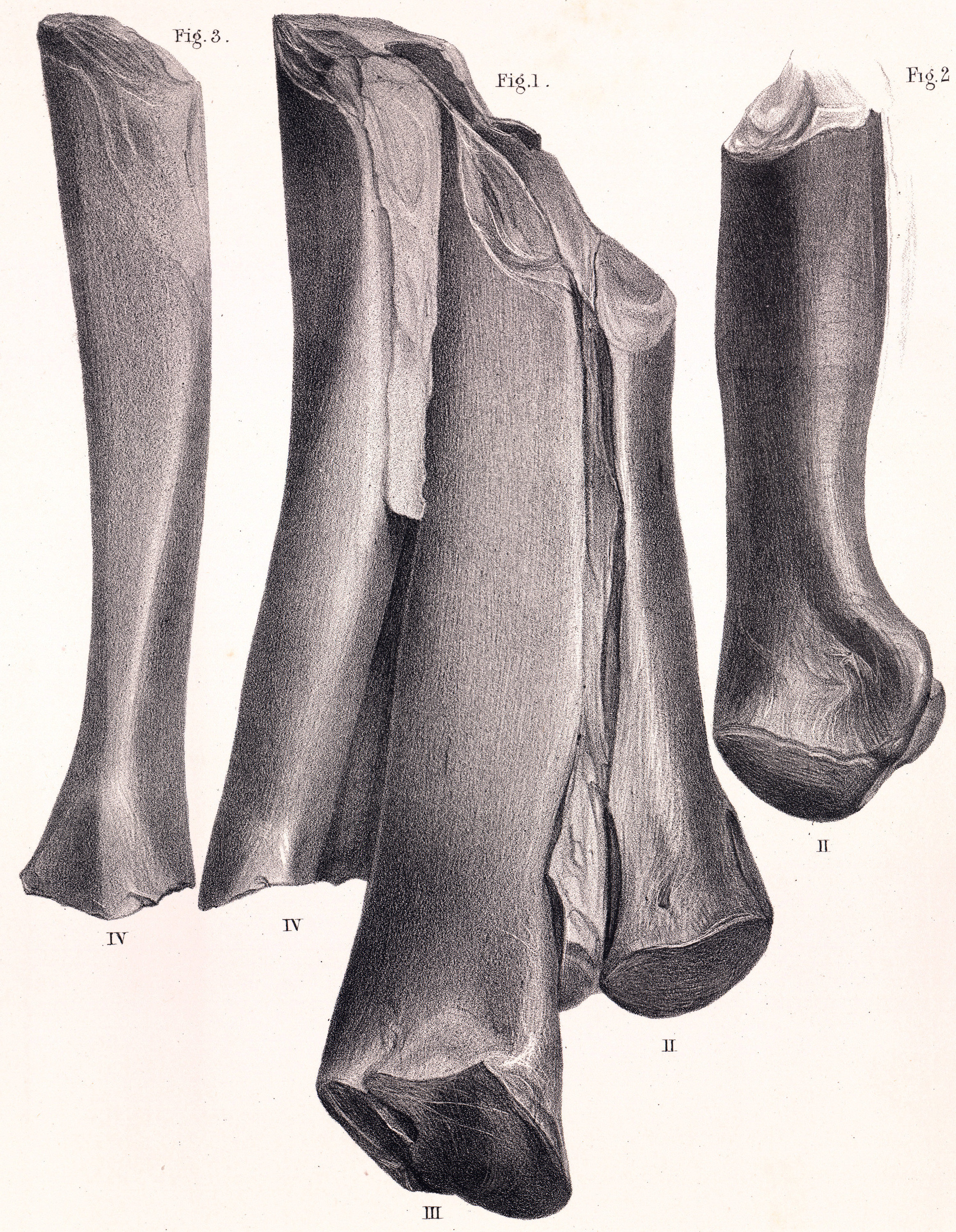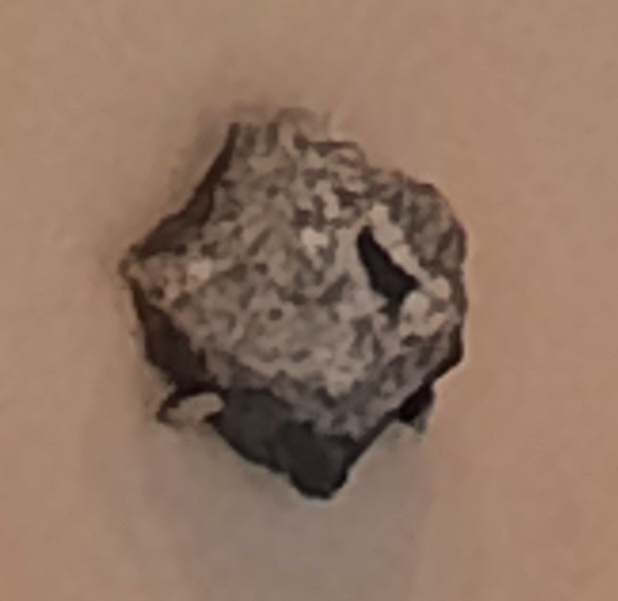Valdoraptor on:
[Wikipedia]
[Google]
[Amazon]
''Valdoraptor'' (meaning "Wealden plunderer") is a
 In 1858
In 1858  By 1881
By 1881
genus
Genus (; : genera ) is a taxonomic rank above species and below family (taxonomy), family as used in the biological classification of extant taxon, living and fossil organisms as well as Virus classification#ICTV classification, viruses. In bino ...
of theropod
Theropoda (; from ancient Greek , (''therion'') "wild beast"; , (''pous, podos'') "foot"">wiktionary:ποδός"> (''pous, podos'') "foot" is one of the three major groups (clades) of dinosaurs, alongside Ornithischia and Sauropodom ...
dinosaur
Dinosaurs are a diverse group of reptiles of the clade Dinosauria. They first appeared during the Triassic Geological period, period, between 243 and 233.23 million years ago (mya), although the exact origin and timing of the #Evolutio ...
from the Early Cretaceous
The Cretaceous ( ) is a geological period that lasted from about 143.1 to 66 mya (unit), million years ago (Mya). It is the third and final period of the Mesozoic Era (geology), Era, as well as the longest. At around 77.1 million years, it is the ...
. Its fossils were found in England
England is a Countries of the United Kingdom, country that is part of the United Kingdom. It is located on the island of Great Britain, of which it covers about 62%, and List of islands of England, more than 100 smaller adjacent islands. It ...
. It is known only from bones of the feet. The holotype
A holotype (Latin: ''holotypus'') is a single physical example (or illustration) of an organism used when the species (or lower-ranked taxon) was formally described. It is either the single such physical example (or illustration) or one of s ...
, BMNH R2559 (incorrectly given by Owen as BMNH R2556), was found near Cuckfield
Cuckfield ( ) is a village and civil parishes in England, civil parish in the Mid Sussex District, Mid Sussex District of West Sussex, England, on the southern slopes of the Weald. It lies south of London, north of Brighton, and east northea ...
in layers of the Tunbridge Wells Sand Formation
The Tunbridge Wells Sand Formation is a geological unit which forms part of the Wealden Group and the uppermost and youngest part of the unofficial Hastings Beds. These geological units make up the core of the geology of the Weald in the English ...
dating from the late Valanginian
In the geologic timescale, the Valanginian is an age or stage of the Early or Lower Cretaceous. It spans between 137.05 ± 0.2 Ma and 132.6 ± 0.2 Ma (million years ago). The Valanginian Stage succeeds the Berriasian Stage of the Lower Cretac ...
. The specimen is damaged lacking parts of the upper and lower ends. It has a conserved length of and an estimated length of . This genus is paleontologically significant for being the first ornithomimosaur specimen known from England and represents the earliest record of ornithomimosaurs.
Discovery
 In 1858
In 1858 Richard Owen
Sir Richard Owen (20 July 1804 – 18 December 1892) was an English biologist, comparative anatomy, comparative anatomist and paleontology, palaeontologist. Owen is generally considered to have been an outstanding naturalist with a remarkabl ...
referred a fossil consisting of a set of three metatarsal
The metatarsal bones or metatarsus (: metatarsi) are a group of five long bones in the midfoot, located between the tarsal bones (which form the heel and the ankle) and the phalanges ( toes). Lacking individual names, the metatarsal bones are ...
s, foot bones, part of the collection of the British Museum of Natural History
The Natural History Museum in London is a museum that exhibits a vast range of specimens from various segments of natural history. It is one of three major museums on Exhibition Road in South Kensington, the others being the Science Museum (Lo ...
, to the herbivorous dinosaur genus ''Hylaeosaurus
''Hylaeosaurus'' ( ; Greek: / "belonging to the forest" and / "lizard") is a herbivorous ankylosaurian dinosaur that lived about 136 million years ago, in the late Valanginian stage of the early Cretaceous period of England. It was found i ...
'' because of its size and bone texture. Owen had a lithograph
Lithography () is a planographic method of printing originally based on the miscibility, immiscibility of oil and water. The printing is from a stone (lithographic limestone) or a metal plate with a smooth surface. It was invented in 1796 by ...
made of the bones that gave a mirrored image: although they were in fact from the left foot, it now seemed they were from the right foot.
 By 1881
By 1881 John Whitaker Hulke
John Whitaker Hulke FRCS FRS FGS (6 November 1830 – 19 February 1895) was a British surgeon, geologist and fossil collector. He was the son of a physician in Deal, who became a Huxleyite despite being deeply religious.
Hulke became Huxley' ...
had recognised that the specimen represented a foot from a carnivorous theropod. In 1888 Richard Lydekker
Richard Lydekker (; 25 July 1849 – 16 April 1915) was a British naturalist, geologist and writer of numerous books on natural history. He was known for his contributions to zoology, paleontology, and biogeography. He worked extensively in cata ...
referred the specimen to the theropod species '' Megalosaurus dunkeri'' but in 1889 he named a separate species for it because of the more robust build: ''Megalosaurus oweni''. The specific name Specific name may refer to:
* in Database management systems, a system-assigned name that is unique within a particular database
In taxonomy, either of these two meanings, each with its own set of rules:
* Specific name (botany), the two-part (bino ...
honours Owen. Lydekker was deceived by the 1858 illustration into thinking that it was the right foot. He also incorrectly assumed it had four metatarsals, a mistake repeated for over a century. Lydekker referred several other foot specimens to the species: BMNH 2574, 2661 and 2680 from the same stratigraphic horizon, and also BMNH R604d and BMNH R1525, uncovered from the earlier Wadhurst Clay Formation
The Wadhurst Clay Formation is a geological unit which forms part of the Wealden Group and the middle part of the now unofficial Hastings Beds. These geological units make up the core of the geology of the High Weald in the English counties of West ...
in the ''Hollington Quarry'' near Hastings
Hastings ( ) is a seaside town and Borough status in the United Kingdom, borough in East Sussex on the south coast of England,
east of Lewes and south east of London. The town gives its name to the Battle of Hastings, which took place to th ...
.
Classification
Though originally classified as a species of ''Megalosaurus'', in 1923Friedrich von Huene
Baron Friedrich Richard von Hoyningen-Huene (22 March 1875 – 4 April 1969) was a German nobleman paleontologist who described a large number of dinosaurs, more than anyone else in 20th-century Europe. He studied a range of Permo-Carbonife ...
assigned the species to ''Altispinax
''Altispinax'' (; "with high spines") is a genus of large predatory theropod dinosaur from the Early Cretaceous period (Valanginian, 140 to 133 million years ago) of what is now the Wadhurst Clay Formation of East Sussex, England.
History
Proba ...
'', making the combination ''Altipsinax oweni''. In 1991 George Olshevsky placed the species in a new genus, ''Valdoraptor'', renaming its type species
In International_Code_of_Zoological_Nomenclature, zoological nomenclature, a type species (''species typica'') is the species name with which the name of a genus or subgenus is considered to be permanently taxonomically associated, i.e., the spe ...
''Megalosaurus oweni'' into ''Valdoraptor oweni''. The generic name is derived from Latin
Latin ( or ) is a classical language belonging to the Italic languages, Italic branch of the Indo-European languages. Latin was originally spoken by the Latins (Italic tribe), Latins in Latium (now known as Lazio), the lower Tiber area aroun ...
''Valdus'', "Wealden", referring to the Wealden Group
The Wealden Group, occasionally also referred to as the Wealden Supergroup, is a group (stratigraphy), group (a sequence of rock strata) in the lithostratigraphy of southern England. The Wealden group consists of wiktionary:paralic, paralic to c ...
, and ''raptor'', "plunderer".
The species has since been suggested to be identical to either ''Neovenator
''Neovenator'' ( nˈiːə͡ʊvˌɛne͡ɪtə; "new hunter") is a genus of carcharodontosaurian theropod dinosaur. It is known primarily from several skeletons found in the Early Cretaceous (Hauterivian-Barremian) Wessex Formation on the south co ...
'' or ''Eotyrannus
''Eotyrannus'' (meaning "dawn tyrant") is a genus of tyrannosauroid theropod dinosaur hailing from the Early Cretaceous Wessex Formation beds, included in Wealden Group, located in the southwest coast of the Isle of Wight, United Kingdom. The re ...
''; it has also been held to be a ''nomen dubium
In binomial nomenclature, a ''nomen dubium'' (Latin for "doubtful name", plural ''nomina dubia'') is a scientific name that is of unknown or doubtful application.
Zoology
In case of a ''nomen dubium,'' it may be impossible to determine whether a ...
''. However, Darren Naish
Darren William Naish (born 26 September 1975) is a British vertebrate palaeontologist, author and science communicator.
As a researcher, he is best known for his work describing and reevaluating dinosaurs and other Mesozoic reptiles, including ...
in 2007 concluded that the specimen showed two unique derived traits or autapomorphies
In phylogenetics, an autapomorphy is a distinctive feature, known as a derived trait, that is unique to a given taxon. That is, it is found only in one taxon, but not found in any others or outgroup taxa, not even those most closely related to ...
, in that the second metatarsal is both mediolaterally compressed and features a prominent dorsolateral ridge. These traits imply it is a valid taxon and different from ''Neovenator'' and ''Eotyrannus''.
Olshevsky assigned ''Valdoraptor'' to the Allosauridae
Allosauridae is an extinct family of medium to large bipedal, carnivorous allosauroid theropod dinosaurs from the Late Jurassic. Allosauridae is a fairly old taxonomic group, having been first named by the American paleontologist Othniel Cha ...
but Naish in 2007 stated that no more precise determination was possible than the more general Tetanurae
Tetanurae (/ˌtɛtəˈnjuːriː/ or "stiff tails") is a clade that includes most Theropoda, theropod dinosaurs, including Megalosauroidea, megalosauroids, Allosauroidea, allosauroids, and Coelurosauria, coelurosaurs (which includes Tyrannosauroi ...
. A 2014 re-evaluation found that ''Valdoraptor'' was likely one of the oldest known ornithomimosaurs, and a possible junior synonym of '' Thecocoelurus''.R. Allain, R. Vullo, J. Le loeuff & J.-F. Tournepiche (2014) European ornithomimosaurs (Dinosauria, Theropoda): an undetected record. Geologica Acta 12(2) (advance online publication) June 2014.
See also
*Timeline of ornithomimosaur research
This timeline of ornithomimosaur research is a chronological listing of events in the History of paleontology, history of paleontology focused on the ornithomimosaurs, a group of bird-like theropods popularly known as the ostrich dinosaurs. Altho ...
References
{{Portalbar, Dinosaurs, England Ornithomimosauria Dinosaur genera Valanginian dinosaurs Taxa named by Richard Lydekker Taxa named by George Olshevsky Fossil taxa described in 1889 Fossil taxa described in 1991 Dinosaurs of the United Kingdom